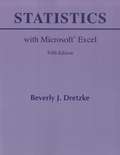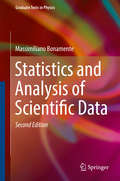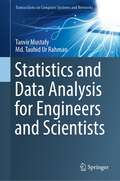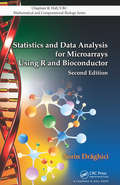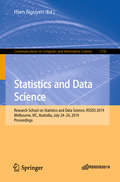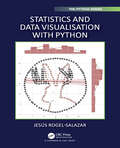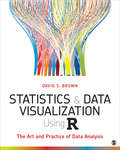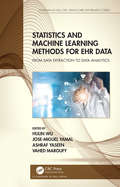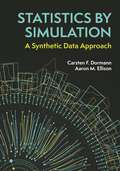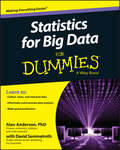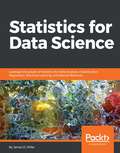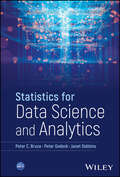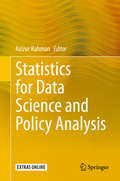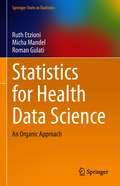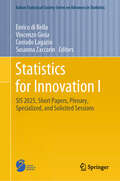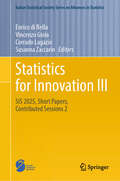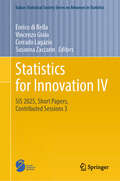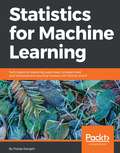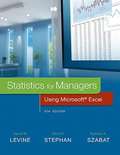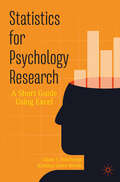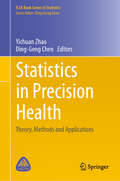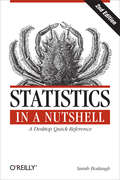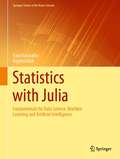- Table View
- List View
Statistics Using IBM SPSS: An Integrative Approach
by Sharon Lawner Weinberg Sarah Knapp AbramowitzWritten in a clear and lively tone, Statistics Using IBM SPSS provides a data-centric approach to statistics with integrated SPSS (version 22) commands, ensuring that students gain both a deep conceptual understanding of statistics and practical facility with the leading statistical software package. With 100 worked examples, the textbook guides students through statistical practice using real data and avoids complicated mathematics. Numerous end-of-chapter exercises allow students to apply and test their understanding of chapter topics, with detailed answers available online. The third edition has been updated throughout and includes a new chapter on research design, new topics (including weighted mean, resampling with the bootstrap, the role of the syntax file in workflow management, and regression to the mean), and new examples and exercises. Student learning is supported by a rich suite of online resources, including answers to end-of-chapter exercises, real data sets, PowerPoint slides, and a test bank. Avoids calculus and linear algebra and instead grounds concepts in real data examples to ensure simple and clear explanation. Written by highly experienced teachers. Chapter examples and exercises are based on real data, which enables students to understand what it truly means to be a data analys.
Statistics With Microsoft Excel (Fifth Edition)
by Beverly DretzkeStatistics with Microsoft Excel, Fifth Edition, shows readers how to use Microsoft Excel® to perform statistical analysis. This step-by-step guide has been updated to cover the new features and interface of Excel 2010. Datasets and other resources (where applicable) for this book are available here.
Statistics and Analysis of Scientific Data
by Massimiliano BonamenteThe revised second edition of this textbook provides the reader with a solid foundation in probability theory and statistics as applied to the physical sciences, engineering and related fields. It covers a broad range of numerical and analytical methods that are essential for the correct analysis of scientific data, including probability theory, distribution functions of statistics, fits to two-dimensional data and parameter estimation, Monte Carlo methods and Markov chains. Features new to this edition include: * a discussion of statistical techniques employed in business science, such as multiple regression analysis of multivariate datasets. * a new chapter on the various measures of the mean including logarithmic averages. * new chapters on systematic errors and intrinsic scatter, and on the fitting of data with bivariate errors. * a new case study and additional worked examples. * mathematical derivations and theoretical background material have been appropriately marked, to improve the readability of the text. * end-of-chapter summary boxes, for easy reference. As in the first edition, the main pedagogical method is a theory-then-application approach, where emphasis is placed first on a sound understanding of the underlying theory of a topic, which becomes the basis for an efficient and practical application of the material. The level is appropriate for undergraduates and beginning graduate students, and as a reference for the experienced researcher. Basic calculus is used in some of the derivations, and no previous background in probability and statistics is required. The book includes many numerical tables of data, as well as exercises and examples to aid the readers' understanding of the topic.
Statistics and Data Analysis for Engineers and Scientists (Transactions on Computer Systems and Networks)
by Tanvir Mustafy Md. Tauhid RahmanThis textbook summarizes the different statistical, scientific, and financial data analysis methods for users ranging from a high school level to a professional level. It aims to combine the data analysis methods using three different programs—Microsoft Excel, SPSS, and MATLAB. The book combining the different data analysis tools is a unique approach. The book presents a variety of real-life problems in data analysis and machine learning, delivering the best solution. Analysis methods presented in this book include but are not limited to, performing various algebraic and trigonometric operations, regression modeling, and correlation, as well as plotting graphs and charts to represent the results. Fundamental concepts of applied statistics are also explained here, with illustrative examples. Thus, this book presents a pioneering solution to help a wide range of students, researchers, and professionals learn data processing, interpret different findings derived from the analyses, and apply them to their research or professional fields. The book also includes worked examples of practical problems. The primary focus behind designing these examples is understanding the concepts of data analysis and how it can solve problems. The chapters include practice exercises to assist users in enhancing their skills to execute statistical analysis calculations using software instead of relying on tables for probabilities and percentiles in the present world.
Statistics and Data Analysis for Microarrays Using R and Bioconductor (Chapman & Hall/CRC Computational Biology Series)
by Sorin DraghiciRichly illustrated in color, Statistics and Data Analysis for Microarrays Using R and Bioconductor, Second Edition provides a clear and rigorous description of powerful analysis techniques and algorithms for mining and interpreting biological information. Omitting tedious details, heavy formalisms, and cryptic notations, the text takes a hands-on, example-based approach that teaches students the basics of R and microarray technology as well as how to choose and apply the proper data analysis tool to specific problems.New to the Second EditionCompletely updated and double the size of its predecessor, this timely second edition replaces the commercial software with the open source R and Bioconductor environments. Fourteen new chapters cover such topics as the basic mechanisms of the cell, reliability and reproducibility issues in DNA microarrays, basic statistics and linear models in R, experiment design, multiple comparisons, quality control, data pre-processing and normalization, Gene Ontology analysis, pathway analysis, and machine learning techniques. Methods are illustrated with toy examples and real data and the R code for all routines is available on an accompanying downloadable resource.With all the necessary prerequisites included, this best-selling book guides students from very basic notions to advanced analysis techniques in R and Bioconductor. The first half of the text presents an overview of microarrays and the statistical elements that form the building blocks of any data analysis. The second half introduces the techniques most commonly used in the analysis of microarray data.
Statistics and Data Science: Research School on Statistics and Data Science, RSSDS 2019, Melbourne, VIC, Australia, July 24–26, 2019, Proceedings (Communications in Computer and Information Science #1150)
by Hien NguyenThis book constitutes the proceedings of the Research School on Statistics and Data Science, RSSDS 2019, held in Melbourne, VIC, Australia, in July 2019. The 11 papers presented in this book were carefully reviewed and selected from 23 submissions. The volume also contains 7 invited talks. The workshop brought together academics, researchers, and industry practitioners of statistics and data science, to discuss numerous advances in the disciplines and their impact on the sciences and society. The topics covered are data analysis, data science, data mining, data visualization, bioinformatics, machine learning, neural networks, statistics, and probability.
Statistics and Data Visualisation with Python (Chapman & Hall/CRC The Python Series)
by Jesus Rogel-SalazarThis book is intended to serve as a bridge in statistics for graduates and business practitioners interested in using their skills in the area of data science and analytics as well as statistical analysis in general. On the one hand, the book is intended to be a refresher for readers who have taken some courses in statistics, but who have not necessarily used it in their day-to-day work. On the other hand, the material can be suitable for readers interested in the subject as a first encounter with statistical work in Python. Statistics and Data Visualisation with Python aims to build statistical knowledge from the ground up by enabling the reader to understand the ideas behind inferential statistics and begin to formulate hypotheses that form the foundations for the applications and algorithms in statistical analysis, business analytics, machine learning, and applied machine learning. This book begins with the basics of programming in Python and data analysis, to help construct a solid basis in statistical methods and hypothesis testing, which are useful in many modern applications.
Statistics and Data Visualization Using R: The Art and Practice of Data Analysis
by David S. BrownDesigned to introduce students to quantitative methods in a way that can be applied to all kinds of data in all kinds of situations, Statistics and Data Visualization Using R: The Art and Practice of Data Analysis by David S. Brown teaches students statistics through charts, graphs, and displays of data that help students develop intuition around statistics as well as data visualization skills. By focusing on the visual nature of statistics instead of mathematical proofs and derivations, students can see the relationships between variables that are the foundation of quantitative analysis. Using the latest tools in R and R RStudio® for calculations and data visualization, students learn valuable skills they can take with them into a variety of future careers in the public sector, the private sector, or academia. Starting at the most basic introduction to data and going through most crucial statistical methods, this introductory textbook quickly gets students new to statistics up to speed running analyses and interpreting data from social science research.
Statistics and Data Visualization Using R: The Art and Practice of Data Analysis
by David S. BrownDesigned to introduce students to quantitative methods in a way that can be applied to all kinds of data in all kinds of situations, Statistics and Data Visualization Using R: The Art and Practice of Data Analysis by David S. Brown teaches students statistics through charts, graphs, and displays of data that help students develop intuition around statistics as well as data visualization skills. By focusing on the visual nature of statistics instead of mathematical proofs and derivations, students can see the relationships between variables that are the foundation of quantitative analysis. Using the latest tools in R and R RStudio® for calculations and data visualization, students learn valuable skills they can take with them into a variety of future careers in the public sector, the private sector, or academia. Starting at the most basic introduction to data and going through most crucial statistical methods, this introductory textbook quickly gets students new to statistics up to speed running analyses and interpreting data from social science research.
Statistics and Machine Learning Methods for EHR Data: From Data Extraction to Data Analytics (Chapman & Hall/CRC Healthcare Informatics Series)
by Hulin Wu Jose-Miguel Yamal Ashraf Yaseen Vahed MaroufyThe use of Electronic Health Records (EHR)/Electronic Medical Records (EMR) data is becoming more prevalent for research. However, analysis of this type of data has many unique complications due to how they are collected, processed and types of questions that can be answered. This book covers many important topics related to using EHR/EMR data for research including data extraction, cleaning, processing, analysis, inference, and predictions based on many years of practical experience of the authors. The book carefully evaluates and compares the standard statistical models and approaches with those of machine learning and deep learning methods and reports the unbiased comparison results for these methods in predicting clinical outcomes based on the EHR data. Key Features: Written based on hands-on experience of contributors from multidisciplinary EHR research projects, which include methods and approaches from statistics, computing, informatics, data science and clinical/epidemiological domains. Documents the detailed experience on EHR data extraction, cleaning and preparation Provides a broad view of statistical approaches and machine learning prediction models to deal with the challenges and limitations of EHR data. Considers the complete cycle of EHR data analysis. The use of EHR/EMR analysis requires close collaborations between statisticians, informaticians, data scientists and clinical/epidemiological investigators. This book reflects that multidisciplinary perspective.
Statistics by Simulation: A Synthetic Data Approach
by Aaron M. Ellison Carsten F. DormannAn accessible guide to understanding statistics using simulations, with examples from a range of scientific disciplinesReal-world challenges such as small sample sizes, skewed distributions of data, biased sampling designs, and more predictors than data points are pushing the limits of classical statistical analysis. This textbook provides a new tool for the statistical toolkit: data simulations. It shows that using simulation and data-generating models is an excellent way to validate statistical reasoning and to augment study design and statistical analysis with planning and visualization. Although data simulations are not new to professional statisticians, Statistics by Simulation makes the approach accessible to a broader audience, with examples from many fields. It introduces the reasoning behind data simulation and then shows how to apply it in planning experiments or observational studies, developing analytical workflows, deploying model diagnostics, and developing new indices and statistical methods.• Covers all steps of statistical practice, from planning projects to post-hoc analysis and model checking• Provides examples from disciplines including sociology, psychology, ecology, economics, physics, and medicine• Includes R code for all examples, with data and code freely available online• Offers bullet-point outlines and summaries of each chapter• Minimizes the use of jargon and requires only basic statistical background and skills
Statistics for Big Data For Dummies
by David Semmelroth Alan AndersonThe fast and easy way to make sense of statistics for big data Does the subject of data analysis make you dizzy? You've come to the right place! Statistics For Big Data For Dummies breaks this often-overwhelming subject down into easily digestible parts, offering new and aspiring data analysts the foundation they need to be successful in the field. Inside, you'll find an easy-to-follow introduction to exploratory data analysis, the lowdown on collecting, cleaning, and organizing data, everything you need to know about interpreting data using common software and programming languages, plain-English explanations of how to make sense of data in the real world, and much more. Data has never been easier to come by, and the tools students and professionals need to enter the world of big data are based on applied statistics. While the word "statistics" alone can evoke feelings of anxiety in even the most confident student or professional, it doesn't have to. Written in the familiar and friendly tone that has defined the For Dummies brand for more than twenty years, Statistics For Big Data For Dummies takes the intimidation out of the subject, offering clear explanations and tons of step-by-step instruction to help you make sense of data mining--without losing your cool. Helps you to identify valid, useful, and understandable patterns in data Provides guidance on extracting previously unknown information from large databases Shows you how to discover patterns available in big data Gives you access to the latest tools and techniques for working in big data If you're a student enrolled in a related Applied Statistics course or a professional looking to expand your skillset, Statistics For Big Data For Dummies gives you access to everything you need to succeed.
Statistics for Data Science
by James D. MillerGet your statistics basics right before diving into the world of data science About This Book • No need to take a degree in statistics, read this book and get a strong statistics base for data science and real-world programs; • Implement statistics in data science tasks such as data cleaning, mining, and analysis • Learn all about probability, statistics, numerical computations, and more with the help of R programs Who This Book Is For This book is intended for those developers who are willing to enter the field of data science and are looking for concise information of statistics with the help of insightful programs and simple explanation. Some basic hands on R will be useful. What You Will Learn • Analyze the transition from a data developer to a data scientist mindset • Get acquainted with the R programs and the logic used for statistical computations • Understand mathematical concepts such as variance, standard deviation, probability, matrix calculations, and more • Learn to implement statistics in data science tasks such as data cleaning, mining, and analysis • Learn the statistical techniques required to perform tasks such as linear regression, regularization, model assessment, boosting, SVMs, and working with neural networks • Get comfortable with performing various statistical computations for data science programmatically In Detail Data science is an ever-evolving field, which is growing in popularity at an exponential rate. Data science includes techniques and theories extracted from the fields of statistics; computer science, and, most importantly, machine learning, databases, data visualization, and so on. This book takes you through an entire journey of statistics, from knowing very little to becoming comfortable in using various statistical methods for data science tasks. It starts off with simple statistics and then move on to statistical methods that are used in data science algorithms. The R programs for statistical computation are clearly explained along with logic. You will come across various mathematical concepts, such as variance, standard deviation, probability, matrix calculations, and more. You will learn only what is required to implement statistics in data science tasks such as data cleaning, mining, and analysis. You will learn the statistical techniques required to perform tasks such as linear regression, regularization, model assessment, boosting, SVMs, and working with neural networks. By the end of the book, you will be comfortable with performing various statistical computations for data science programmatically. Style and approach Step by step comprehensive guide with real world examples
Statistics for Data Science and Analytics
by Peter C. Bruce Peter Gedeck Janet DobbinsIntroductory statistics textbook with a focus on data science topics such as prediction, correlation, and data exploration Statistics for Data Science and Analytics is a comprehensive guide to statistical analysis using Python, presenting important topics useful for data science such as prediction, correlation, and data exploration. The authors provide an introduction to statistical science and big data, as well as an overview of Python data structures and operations. A range of statistical techniques are presented with their implementation in Python, including hypothesis testing, probability, exploratory data analysis, categorical variables, surveys and sampling, A/B testing, and correlation. The text introduces binary classification, a foundational element of machine learning, validation of statistical models by applying them to holdout data, and probability and inference via the easy-to-understand method of resampling and the bootstrap instead of using a myriad of “kitchen sink” formulas. Regression is taught both as a tool for explanation and for prediction. This book is informed by the authors’ experience designing and teaching both introductory statistics and machine learning at Statistics.com. Each chapter includes practical examples, explanations of the underlying concepts, and Python code snippets to help readers apply the techniques themselves. Statistics for Data Science and Analytics includes information on sample topics such as: Int, float, and string data types, numerical operations, manipulating strings, converting data types, and advanced data structures like lists, dictionaries, and setsExperiment design via randomizing, blinding, and before-after pairing, as well as proportions and percents when handling binary dataSpecialized Python packages like numpy, scipy, pandas, scikit-learn and statsmodels—the workhorses of data science—and how to get the most value from themStatistical versus practical significance, random number generators, functions for code reuse, and binomial and normal probability distributions Written by and for data science instructors, Statistics for Data Science and Analytics is an excellent learning resource for data science instructors prescribing a required intro stats course for their programs, as well as other students and professionals seeking to transition to the data science field.
Statistics for Data Science and Policy Analysis
by Azizur RahmanThis book brings together the best contributions of the Applied Statistics and Policy Analysis Conference 2019. Written by leading international experts in the field of statistics, data science and policy evaluation. This book explores the theme of effective policy methods through the use of big data, accurate estimates and modern computing tools and statistical modelling.
Statistics for Health Data Science: An Organic Approach (Springer Texts in Statistics)
by Ruth Etzioni Micha Mandel Roman GulatiStudents and researchers in the health sciences are faced with greater opportunity and challenge than ever before. The opportunity stems from the explosion in publicly available data that simultaneously informs and inspires new avenues of investigation. The challenge is that the analytic tools required go far beyond the standard methods and models of basic statistics. This textbook aims to equip health care researchers with the most important elements of a modern health analytics toolkit, drawing from the fields of statistics, health econometrics, and data science. This textbook is designed to overcome students’ anxiety about data and statistics and to help them to become confident users of appropriate analytic methods for health care research studies. Methods are presented organically, with new material building naturally on what has come before. Each technique is motivated by a topical research question, explained in non-technical terms, and accompanied by engaging explanations and examples. In this way, the authors cultivate a deep (“organic”) understanding of a range of analytic techniques, their assumptions and data requirements, and their advantages and limitations. They illustrate all lessons via analyses of real data from a variety of publicly available databases, addressing relevant research questions and comparing findings to those of published studies. Ultimately, this textbook is designed to cultivate health services researchers that are thoughtful and well informed about health data science, rather than data analysts. This textbook differs from the competition in its unique blend of methods and its determination to ensure that readers gain an understanding of how, when, and why to apply them. It provides the public health researcher with a way to think analytically about scientific questions, and it offers well-founded guidance for pairing data with methods for valid analysis. Readers should feel emboldened to tackle analysis of real public datasets using traditional statistical models, health econometrics methods, and even predictive algorithms. Accompanying code and data sets are provided in an author site: https://roman-gulati.github.io/statistics-for-health-data-science/
Statistics for Innovation I: SIS 2025, Short Papers, Plenary, Specialized, and Solicited Sessions (Italian Statistical Society Series on Advances in Statistics)
by Enrico Di Bella Vincenzo Gioia Corrado Lagazio Susanna ZaccarinThis book presents peer-reviewed short papers on methodological and applied statistical research presented at the Italian Statistical Society&’s international conference on &“Statistics for Innovation&”, SIS 2025, held in Genoa, Italy, June 16-18, 2025. It is the first of four volumes, featuring invited contributions presented in the Plenary, Specialized and Solicited Sessions. Providing a comprehensive overview of innovations in modern statistical methods and applications, the volumes address a large number of topics of current interest, contributing to a rapid dissemination of quantitative methods for data analysis across the various fields of scientific research and social life. The volumes underpin the role of statistics and data science in fostering innovation in numerous fields, including business, industry, finance, technology, environment, health and medicine, official statistics, public policy, welfare, social issues and sustainable development. One of the aims of the Italian Statistical Society (SIS) is to promote scientific activities for the development of statistical sciences. Together with the biennial international Scientific Meeting, the intermediate international statistical conferences on a particular topic of interest represent the Society&’s most important events which bring together national and international researchers and professionals to exchange ideas and discuss recent advances and developments in theoretical and applied statistics.
Statistics for Innovation III: SIS 2025, Short Papers, Contributed Sessions 2 (Italian Statistical Society Series on Advances in Statistics)
by Enrico Di Bella Vincenzo Gioia Corrado Lagazio Susanna ZaccarinThis book presents peer-reviewed short papers on methodological and applied statistical research presented at the Italian Statistical Society&’s international conference on &“Statistics for Innovation&”, SIS 2025, held in Genoa, Italy, June 16-18, 2025. It is the third of four volumes, featuring the second part of the contributions presented in the Contributed Sessions. Providing a comprehensive overview of innovations in modern statistical methods and applications, the volumes address a large number of topics of current interest, contributing to a rapid dissemination of quantitative methods for data analysis across the various fields of scientific research and social life. The volumes underpin the role of statistics and data science in fostering innovation in numerous fields, including business, industry, finance, technology, environment, health and medicine, official statistics, public policy, welfare, social issues and sustainable development. One of the aims of the Italian Statistical Society (SIS) is to promote scientific activities for the development of statistical sciences. Together with the biennial international Scientific Meeting, the intermediate international statistical conferences on a particular topic of interest represent the Society&’s most important events which bring together national and international researchers and professionals to exchange ideas and discuss recent advances and developments in theoretical and applied statistics.
Statistics for Innovation IV: SIS 2025, Short Papers, Contributed Sessions 3 (Italian Statistical Society Series on Advances in Statistics)
by Enrico Di Bella Vincenzo Gioia Corrado Lagazio Susanna ZaccarinThis book presents peer-reviewed short papers on methodological and applied statistical research presented at the Italian Statistical Society&’s international conference on &“Statistics for Innovation&”, SIS 2025, held in Genoa, Italy, June 16-18, 2025. It is the last of four volumes, featuring the third part of the contributions presented in the Contributed Sessions. Providing a comprehensive overview of innovations in modern statistical methods and applications, the volumes address a large number of topics of current interest, contributing to a rapid dissemination of quantitative methods for data analysis across the various fields of scientific research and social life. The volumes underpin the role of statistics and data science in fostering innovation in numerous fields, including business, industry, finance, technology, environment, health and medicine, official statistics, public policy, welfare, social issues and sustainable development. One of the aims of the Italian Statistical Society (SIS) is to promote scientific activities for the development of statistical sciences. Together with the biennial international Scientific Meeting, the intermediate international statistical conferences on a particular topic of interest represent the Society&’s most important events which bring together national and international researchers and professionals to exchange ideas and discuss recent advances and developments in theoretical and applied statistics.
Statistics for Machine Learning
by Pratap DangetiBuild Machine Learning models with a sound statistical understanding. About This Book • Learn about the statistics behind powerful predictive models with p-value, ANOVA, and F- statistics. • Implement statistical computations programmatically for supervised and unsupervised learning through K-means clustering. • Master the statistical aspect of Machine Learning with the help of this example-rich guide to R and Python. Who This Book Is For This book is intended for developers with little to no background in statistics, who want to implement Machine Learning in their systems. Some programming knowledge in R or Python will be useful. What You Will Learn • Understand the Statistical and Machine Learning fundamentals necessary to build models • Understand the major differences and parallels between the statistical way and the Machine Learning way to solve problems • Learn how to prepare data and feed models by using the appropriate Machine Learning algorithms from the more-than-adequate R and Python packages • Analyze the results and tune the model appropriately to your own predictive goals • Understand the concepts of required statistics for Machine Learning • Introduce yourself to necessary fundamentals required for building supervised & unsupervised deep learning models • Learn reinforcement learning and its application in the field of artificial intelligence domain In Detail Complex statistics in Machine Learning worry a lot of developers. Knowing statistics helps you build strong Machine Learning models that are optimized for a given problem statement. This book will teach you all it takes to perform complex statistical computations required for Machine Learning. You will gain information on statistics behind supervised learning, unsupervised learning, reinforcement learning, and more. Understand the real-world examples that discuss the statistical side of Machine Learning and familiarize yourself with it. You will also design programs for performing tasks such as model, parameter fitting, regression, classification, density collection, and more. By the end of the book, you will have mastered the required statistics for Machine Learning and will be able to apply your new skills to any sort of industry problem. Style and approach This practical, step-by-step guide will give you an understanding of the Statistical and Machine Learning fundamentals you'll need to build models.
Statistics for Managers Using Microsoft Excel
by David Levine David Stephan Kathryn Szabat<p>For undergraduate business statistics courses. Analyzing the Data Applicable to Business. This text is the gold standard for learning how to use Microsoft Excel® in business statistics, helping students gain the understanding they need to be successful in their careers. The authors present statistics in the context of specific business fields; full chapters on business analytics further prepare students for success in their professions. Current data throughout the text lets students practice analyzing the types of data they will see in their professions. The friendly writing style include tips throughout to encourage learning. <p>The book also integrates PHStat, an add-in that bolsters the statistical functions of Excel.</p>
Statistics for Psychology Research: A Short Guide Using Excel
by Adam T. Hutcheson Kristina Groce BrownThis book aims to help psychology students build their skills to conduct research and analyses using Microsoft Excel’s Data Analysis Toolpak. Concise yet comprehensive, this accessible textbook walks students through basic research methodology, central tendency, variability, standardized scores, t-tests (independent and related samples), One-way Analysis of Variance (between-groups and repeated measures), the Pearson correlation, and Chi Square analyses. Each chapter includes examples of research questions to be addressed, the rationale for the analysis, a step-by-step analysis of the dataset in equation format and using Microsoft Excel, and how to present results in APA (7th Edition) style. The extensive didactic material encompasses end-of-chapter questions, learning outcomes, sidebar boxes with common mistakes to avoid, and biographical sketches of those who developed research methods and statistical techniques. Students and instructors will also benefit from a companion website where PowerPoint slides and additional exercises, datasets, and resources are available. Ideal for undergraduate psychology courses, this textbook can also be of use for those interested in learning more about statistical research and its practical application at university and beyond. Test your knowledge with questions and answers about the book with Springer Nature Flashcards.
Statistics in Precision Health: Theory, Methods and Applications (ICSA Book Series in Statistics)
by Ding-Geng Chen Yichuan ZhaoThis book discusses statistical methods and their innovative applications in precision health. It serves as a valuable resource to foster the development of this growing field within the context of the big data era. The chapters cover a wide range of topics, including foundational principles, statistical theories, new procedures, advanced methods, and practical applications in precision medicine. Particular attention is devoted to the interplay between precision health, big data, and mobile health research, while also exploring precision medicine's role in clinical trials, electronic health record data analysis, survival analysis, and genomic studies. Targeted at data scientists, statisticians, graduate students, and researchers in academia, industry, and government, this book offers insights into the latest advances in personalized medicine using advanced statistical techniques.
Statistics in a Nutshell: A Desktop Quick Reference (In A Nutshell (o'reilly) Ser.)
by Sarah BoslaughNeed to learn statistics for your job? Want help passing a statistics course? Statistics in a Nutshell is a clear and concise introduction and reference for anyone new to the subject. Thoroughly revised and expanded, this edition helps you gain a solid understanding of statistics without the numbing complexity of many college texts.Each chapter presents easy-to-follow descriptions, along with graphics, formulas, solved examples, and hands-on exercises. If you want to perform common statistical analyses and learn a wide range of techniques without getting in over your head, this is your book.Learn basic concepts of measurement and probability theory, data management, and research designDiscover basic statistical procedures, including correlation, the t-test, the chi-square and Fisherâ??s exact tests, and techniques for analyzing nonparametric dataLearn advanced techniques based on the general linear model, including ANOVA, ANCOVA, multiple linear regression, and logistic regressionUse and interpret statistics for business and quality improvement, medical and public health, and education and psychologyCommunicate with statistics and critique statistical information presented by others
Statistics with Julia: Fundamentals for Data Science, Machine Learning and Artificial Intelligence (Springer Series in the Data Sciences)
by Yoni Nazarathy Hayden KlokThis monograph uses the Julia language to guide the reader through an exploration of the fundamental concepts of probability and statistics, all with a view of mastering machine learning, data science, and artificial intelligence. The text does not require any prior statistical knowledge and only assumes a basic understanding of programming and mathematical notation. It is accessible to practitioners and researchers in data science, machine learning, bio-statistics, finance, or engineering who may wish to solidify their knowledge of probability and statistics. The book progresses through ten independent chapters starting with an introduction of Julia, and moving through basic probability, distributions, statistical inference, regression analysis, machine learning methods, and the use of Monte Carlo simulation for dynamic stochastic models. Ultimately this text introduces the Julia programming language as a computational tool, uniquely addressing end-users rather than developers. It makes heavy use of over 200 code examples to illustrate dozens of key statistical concepts. The Julia code, written in a simple format with parameters that can be easily modified, is also available for download from the book’s associated GitHub repository online.See what co-creators of the Julia language are saying about the book:Professor Alan Edelman, MIT: With “Statistics with Julia”, Yoni and Hayden have written an easy to read, well organized, modern introduction to statistics. The code may be looked at, and understood on the static pages of a book, or even better, when running live on a computer. Everything you need is here in one nicely written self-contained reference. Dr. Viral Shah, CEO of Julia Computing: Yoni and Hayden provide a modern way to learn statistics with the Julia programming language. This book has been perfected through iteration over several semesters in the classroom. It prepares the reader with two complementary skills - statistical reasoning with hands on experience and working with large datasets through training in Julia.

